Photo
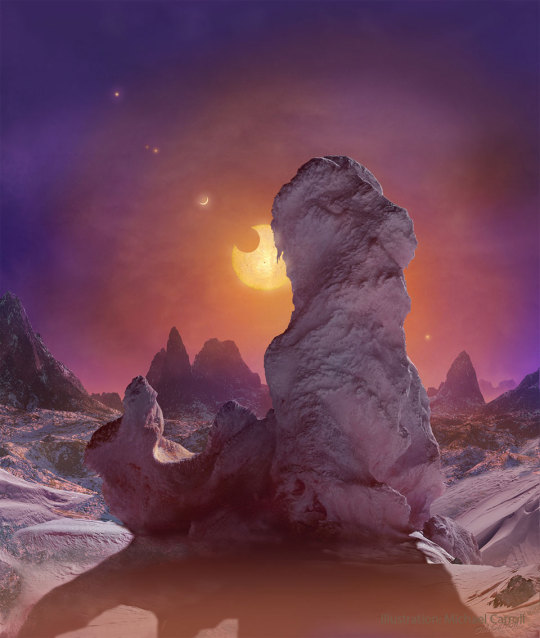
The Seventh World of Trappist-1 - Michael Carroll
Seven worlds orbit the ultracool dwarf star TRAPPIST-1. A mere 40 light-years away, many of the exoplanets were discovered in 2016 using the Transiting Planets and Planetesimals Small Telescope (TRAPPIST) located in the Atlas Mountains of Morocco, and later confirmed with telescope including NASA's Spitzer Space Telescope. The TRAPPIST-1 planets are likely all rocky and similar in size to Earth, and so compose one of the largest treasure troves of terrestrial planets ever detected around a single star. Because they orbit very close to their faint, tiny star they could also have regions where surface temperatures allow for the presence of ice or even liquid water, a key ingredient for life. Their tantalizing proximity to Earth makes them prime candidates for future telescopic explorations of the atmospheres of potentially habitable planets. All seven exoplanets appear in the featured illustration, which imagines a view from the most distant known world of this system, TRAPPIST-1h, as having a rocky landscape covered in ice. Meanwhile, in the imagined background, one of the system's inner planets crosses in front of the dim, orange, nearly Jupiter-sized parent star. Astrophysicists: Browse 3,000+ codes in the Astrophysics Source Code Library
6 notes
·
View notes
Photo

A Triple View of Comet ZTF - Javier CalderaMiguel Gracia
Comet ZTF has a distinctive shape. The now bright comet visiting the inner Solar System has been showing not only a common dust tail, ion tail, and green gas coma, but also an uncommonly distinctive antitail. The antitail does not actually lead the comet -- it is just that the head of the comet is seen superposed on part of the fanned-out and trailing dust tail. The giant dirty snowball that is Comet C/2022 E3 (ZTF) has now passed its closest to the Sun and tomorrow will pass its closest to the Earth. The main panel of the featured triple image shows how Comet ZTF looked last week to the unaided eye under a dark and clear sky over Cáceres, Spain. The top inset image shows how the comet looked through binoculars, while the lower inset shows how the comet looked through a small telescope. The comet is now visible all night long from northern latitudes but will surely fade from easy observation during the next few weeks. Comet ZTF Gallery: Notable Submissions to APOD
2 notes
·
View notes
Photo
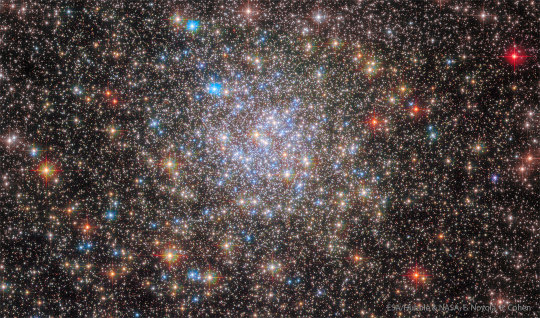
Globular Star Cluster NGC 6355 from Hubble
Globular clusters once ruled the Milky Way. Back in the old days, back when our Galaxy first formed, perhaps thousands of globular clusters roamed our Galaxy. Today, there are less than 200 left. Over the eons, many globular clusters were destroyed by repeated fateful encounters with each other or the Galactic center. Surviving relics are older than any Earth fossil, older than any other structures in our Galaxy, and limit the universe itself in raw age. There are few, if any, young globular clusters left in our Milky Way Galaxy because conditions are not ripe for more to form. The featured image shows a Hubble Space Telescope view of 13-billion year old NGC 6355, a surviving globular cluster currently passing near the Milky Way's center. Globular cluster stars are concentrated toward the image center and highlighted by bright blue stars. Most other stars in the frame are dimmer, redder, and just coincidently lie near the direction to NGC 6355.
1 note
·
View note
Photo
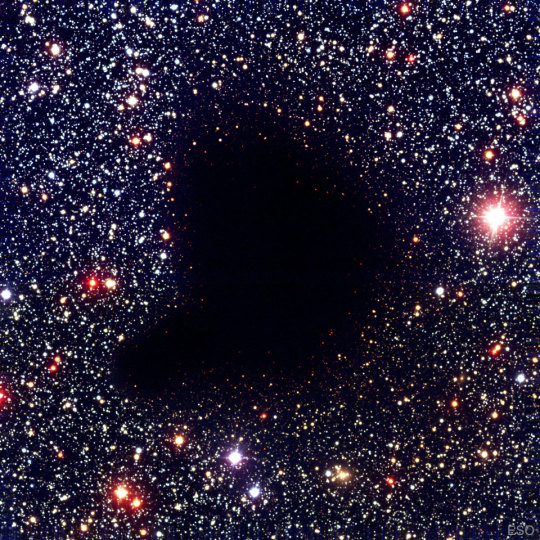
Barnard 68: Dark Molecular Cloud
Where did all the stars go? What used to be considered a hole in the sky is now known to astronomers as a dark molecular cloud. Here, a high concentration of dust and molecular gas absorb practically all the visible light emitted from background stars. The eerily dark surroundings help make the interiors of molecular clouds some of the coldest and most isolated places in the universe. One of the most notable of these dark absorption nebulae is a cloud toward the constellation Ophiuchus known as Barnard 68, pictured here. That no stars are visible in the center indicates that Barnard 68 is relatively nearby, with measurements placing it about 500 light-years away and half a light-year across. It is not known exactly how molecular clouds like Barnard 68 form, but it is known that these clouds are themselves likely places for new stars to form. In fact, Barnard 68 itself has been found likely to collapse and form a new star system. It is possible to look right through the cloud in infrared light. Postcards from the Universe 2022: APOD Year in Review
2 notes
·
View notes
Photo

Comet ZTF over Mount Etna - Dario Giannobile
Comet-like plumes are blowing over the volcanic peaks of Mount Etna in this wintry mountain-and-skyscape from planet Earth. The stacked and blended combination of individual exposures recorded during the cold night of January 23, also capture naked-eye Comet ZTF just above Etna's snowy slopes. Of course increasing sunlight and the solar wind are responsible for the comet's greenish coma and broad dusty tail. This weekend Comet ZTF is dashing across northern skies between north star Polaris and the Big Dipper. From a dark site you can only just spot it as a fuzzy patch though. That's still an impressive achievement if you consider you are gazing at a visitor from the distant Oort cloud with your own eyes. But binoculars or a small telescope will make for an even more enjoyable view of this Comet ZTF in the coming days. Comet ZTF Gallery: Notable Submissions to APOD
0 notes
Photo
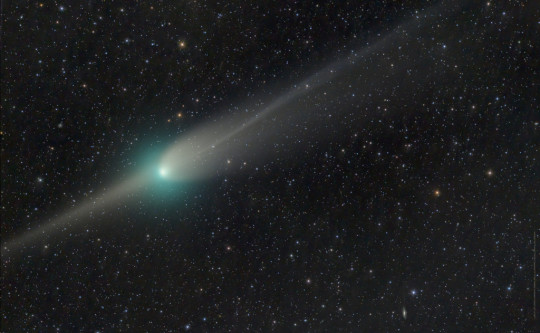
Comet ZTF: Orbital Plane Crossing - Dan Bartlett
The current darling of the northern night, Comet C/2022 E3 ZTF is captured in this telescopic image from a dark sky location at June Lake, California. Of course Comet ZTF has been growing brighter in recent days, headed for its closest approach to Earth on February 1. But this view was recorded on January 23, very close to the time planet Earth crossed the orbital plane of long-period Comet ZTF. The comet's broad, whitish dust tail is still curved and fanned out away from the Sun as Comet ZTF sweeps along its orbit. Due to perspective near the orbital plane crossing, components of the fanned out dust tail appear on both sides of the comet's green tinted coma though, to lend Comet ZTF a visually striking (left) anti-tail. Buffeted by solar activity the comet's narrower ion tail also streams away from the coma diagonally to the right, across the nearly three degree wide field of view.
1 note
·
View note
Photo

Active Galaxy NGC 1275
Active galaxy NGC 1275 is the central, dominant member of the large and relatively nearby Perseus Cluster of Galaxies. Wild-looking at visible wavelengths, the active galaxy is also a prodigious source of x-rays and radio emission. NGC 1275 accretes matter as entire galaxies fall into it, ultimately feeding a supermassive black hole at the galaxy's core. This color composite image made from Hubble Space Telescope data recorded during 2006. It highlights the resulting galactic debris and filaments of glowing gas, some up to 20,000 light-years long. The filaments persist in NGC 1275, even though the turmoil of galactic collisions should destroy them. What keeps the filaments together? Observations indicate that the structures, pushed out from the galaxy's center by the black hole's activity, are held together by magnetic fields. Also known as Perseus A, NGC 1275 spans over 100,000 light years and lies about 230 million light years away.
3 notes
·
View notes
Photo

LDN 1622: The Boogeyman Nebula - Joshua Carter
To some, the dark shape looks like a mythical boogeyman. Scientifically, Lynds' Dark Nebula (LDN) 1622 appears against a faint background of glowing hydrogen gas only visible in long telescopic exposures of the region. In contrast, the brighter reflection nebula vdB 62 is more easily seen just above and to the right of center in the featured image. LDN 1622 lies near the plane of our Milky Way Galaxy, close on the sky to Barnard's Loop, a large cloud surrounding the rich complex of emission nebulae found in the Belt and Sword of Orion. With swept-back outlines, the obscuring dust of LDN 1622 is thought to lie at a similar distance, perhaps 1,500 light-years away. At that distance, this 2-degree wide field of view would span about 60 light-years. Young stars do lie hidden within the dark expanse and have been revealed in Spitzer Space Telescope infrared images.
4 notes
·
View notes
Photo
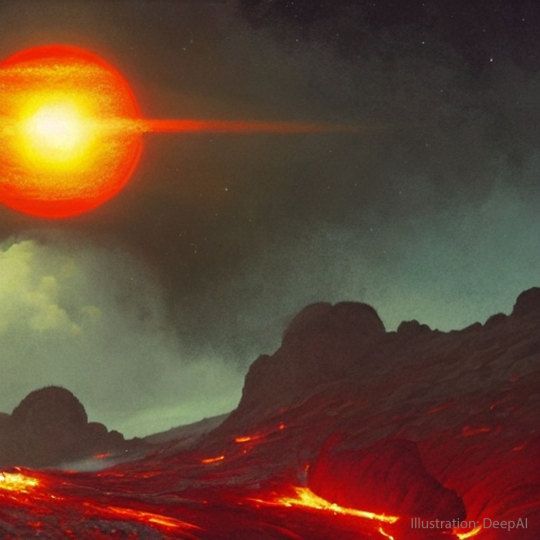
LHS 475 b: Earth-Sized Exoplanet
If you could stand on exoplanet LHS 475 b, what might you see? No one knows for sure but pictured here is an interesting guess made by an Earth-based artificial intelligence (AI) engine. The existence of the exoplanet was indicated in data taken by the Earth-orbiting TESS satellite but confirmed and further investigated only this year by the near-Earth Sun-orbiting James Webb Space Telescope. What is known for sure is that LHS 475 b has a mass very similar to our Earth and closely orbits a small red star about 40 light years away. The featured AI-illustrated guess depicts a plausibly rugged Earth-like landscape replete with molten lava and with the central red star rising in the distance. Webb data does not as yet reveal, however, whether LHS 475 b has an atmosphere. One of Webb’s science objectives is to follow up previous discoveries of distant exoplanets to better discern their potential for developing life. Comet ZTF Gallery: Notable Submissions to APOD
0 notes
Photo
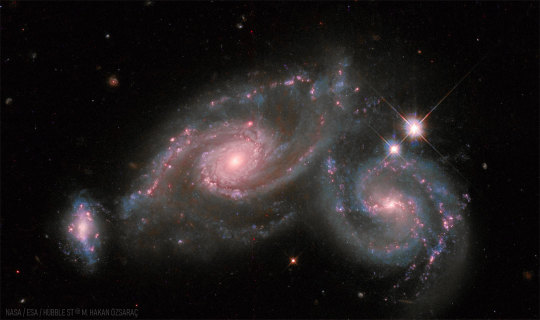
The Colliding Spiral Galaxies of Arp 274
Two galaxies are squaring off in Virgo and here are the latest pictures. When two galaxies collide, the stars that compose them usually do not. This is because galaxies are mostly empty space and, however bright, stars only take up only a small fraction of that space. But during the collision, one galaxy can rip the other apart gravitationally, and dust and gas common to both galaxies does collide. If the two galaxies merge, black holes that likely resided in each galaxy center may eventually merge. Because the distances are so large, the whole thing takes place in slow motion -- over hundreds of millions of years. Besides the two large spiral galaxies, a smaller third galaxy is visible on the far left of the featured image of Arp 274, also known as NGC 5679. Arp 274 spans about 200,000 light years across and lies about 400 million light years away toward the constellation of Virgo. Night Sky Network webinar: APOD editor to review best space images of 2022
1 note
·
View note
Photo

In Green Company: Aurora over Norway - Max Rive
Raise your arms if you see an aurora. With those instructions, two nights went by with, well, clouds -- mostly. On the third night of returning to same peaks, though, the sky not only cleared up but lit up with a spectacular auroral display. Arms went high in the air, patience and experience paid off, and the creative featured image was captured as a composite from three separate exposures. The setting is a summit of the Austnesfjorden fjord close to the town of Svolvear on the Lofoten islands in northern Norway. The time was early 2014. Although our Sun passed the solar minimum of its 11-year cycle only a few years ago, surface activity is picking up and already triggering more spectacular auroras here on Earth.
1 note
·
View note
Photo

Naked-eye Comet ZTF - Organización Salmantina de la Astronáutica y el Espacio
Comet C/2022E3 (ZTF) is no longer too dim to require a telescope for viewing. By January 19, it could just be seen with the naked eye in this rural sky with little light pollution from a location about 20 kilometers from Salamanca, Spain. Still, telescopic images are needed to show any hint of the comet's pretty green coma, stubby whitish dust tail, and long ion tail. Its faint ion tail has been buffeted by recent solar activity. This visitor from the distant Oort cloud rounded the Sun on January 12. and is now sweeping through stars near the northern boundary of the constellation Bootes. Outward bound but still growing brighter, Comet ZTF makes its closest approach on February 2, coming to within about 2.4 light-minutes of our fair planet.
0 notes
Photo

Galaxy Wars: M81 and M82 - Andreas Aufschnaiter
The two dominant galaxies near center are far far away, 12 million light-years distant toward the northern constellation of the Great Bear. On the right, with grand spiral arms and bright yellow core is spiral galaxy M81. Also known as Bode's galaxy, M81 spans some 100,000 light-years. On the left is cigar-shaped irregular galaxy M82. The pair have been locked in gravitational combat for a billion years. Gravity from each galaxy has profoundly affected the other during a series of cosmic close encounters. Their last go-round lasted about 100 million years and likely raised density waves rippling around M81, resulting in the richness of M81's spiral arms. M82 was left with violent star forming regions and colliding gas clouds so energetic that the galaxy glows in X-rays. In the next few billion years, their continuing gravitational encounters will result in a merger, and a single galaxy will remain. This extragalactic scenario also includes other members of the interacting M81 galaxy group with NGC 3077 below and right of the large spiral, and NGC 2976 at upper right in the frame. Captured under dark night skies in the Austrian Alps, the foreground of the wide-field image is filled with integrated flux nebulae. Those faint, dusty interstellar clouds reflect starlight above the plane of our own Milky Way galaxy.
1 note
·
View note
Photo

The Seagull Nebula - Carlos Taylor
A broad expanse of glowing gas and dust presents a bird-like visage to astronomers from planet Earth, suggesting its popular moniker - The Seagull Nebula. Using narrowband image data, this 3-panel mosaic of the cosmic bird covers a 2.5 degree swath across the plane of the Milky Way, near the direction of Sirius, alpha star of the constellation Canis Major. Likely part of a larger shell structure swept up by successive supernova explosions, the broad Seagull Nebula is cataloged as Sh2-296 and IC 2177. The prominent bluish arc below and right of center is a bow shock from runaway star FN Canis Majoris. This complex of gas and dust clouds with other stars of the Canis Majoris OB1 association spans over 200 light-years at the Seagull Nebula's estimated 3,800 light-year distance.
4 notes
·
View notes
Photo

MACS0647: Gravitational Lensing of the Early Universe by Webb
Gravitational lensing by the galaxy cluster MACS0647 -- in which the massive foreground cluster distorts and lenses the light emitted by distant background galaxies along the line of sight — is on vivid display here in this recent multi-color infrared image from the James Webb Space Telescope (JWST). In particular, the background source MACS0647-JD is seen to be lensed three times by the cluster. When first discovered with the Hubble Space Telescope, MACS0647-JD was observed as an amorphous blob. With Webb though, this single source is revealed to be a pair or small group of galaxies. The colors of the MACS0647-JD objects are different as well -- indicating differences potentially in the age or dust content of these galaxies. These new images provide rare examples of galaxies in an era only a few 100 million years after the Big Bang. Explore Your Universe: Random APOD Generator
1 note
·
View note
Photo

Unexpected Clouds Toward the Andromeda Galaxy - Yann SaintyMarcel Drechsler
Why are there oxygen-emitting arcs near the direction of the Andromeda galaxy? No one is sure. The gas arcs, shown in blue, were discovered and first confirmed by amateur astronomers just last year. The two main origin hypotheses for the arcs are that they really are close to Andromeda (M31), or that they are just coincidentally placed gas filaments in our Milky Way galaxy. Adding to the mystery is that arcs were not seen in previous deep images of M31 taken primarily in light emitted by hydrogen, and that other, more distant galaxies have not been generally noted as showing similar oxygen-emitting structures. Dedicated amateurs using commercial telescopes made this discovery because, in part, professional telescopes usually investigate angularly small patches of the night sky, whereas these arcs span several times the angular size of the full moon. Future observations -- both in light emitted by oxygen and by other elements -- are sure to follow.
4 notes
·
View notes
Photo

Moon Enhanced - Darya Kawa Mirza
Our Moon doesn't really look like this. Earth's Moon, Luna, doesn't naturally show this rich texture, and its colors are more subtle. But this digital creation is based on reality. The featured image is a composite of multiple images and enhanced to bring up real surface features. The enhancements, for example, show more clearly craters that illustrate the tremendous bombardment our Moon has been through during its 4.6-billion-year history. The dark areas, called maria, have fewer craters and were once seas of molten lava. Additionally, the image colors, although based on the moon's real composition, are changed and exaggerated. Here, a blue hue indicates a region that is iron rich, while orange indicates a slight excess of aluminum. Although the Moon has shown the same side to the Earth for billions of years, modern technology is allowing humanity to learn much more about it -- and how it affects the Earth.
4 notes
·
View notes